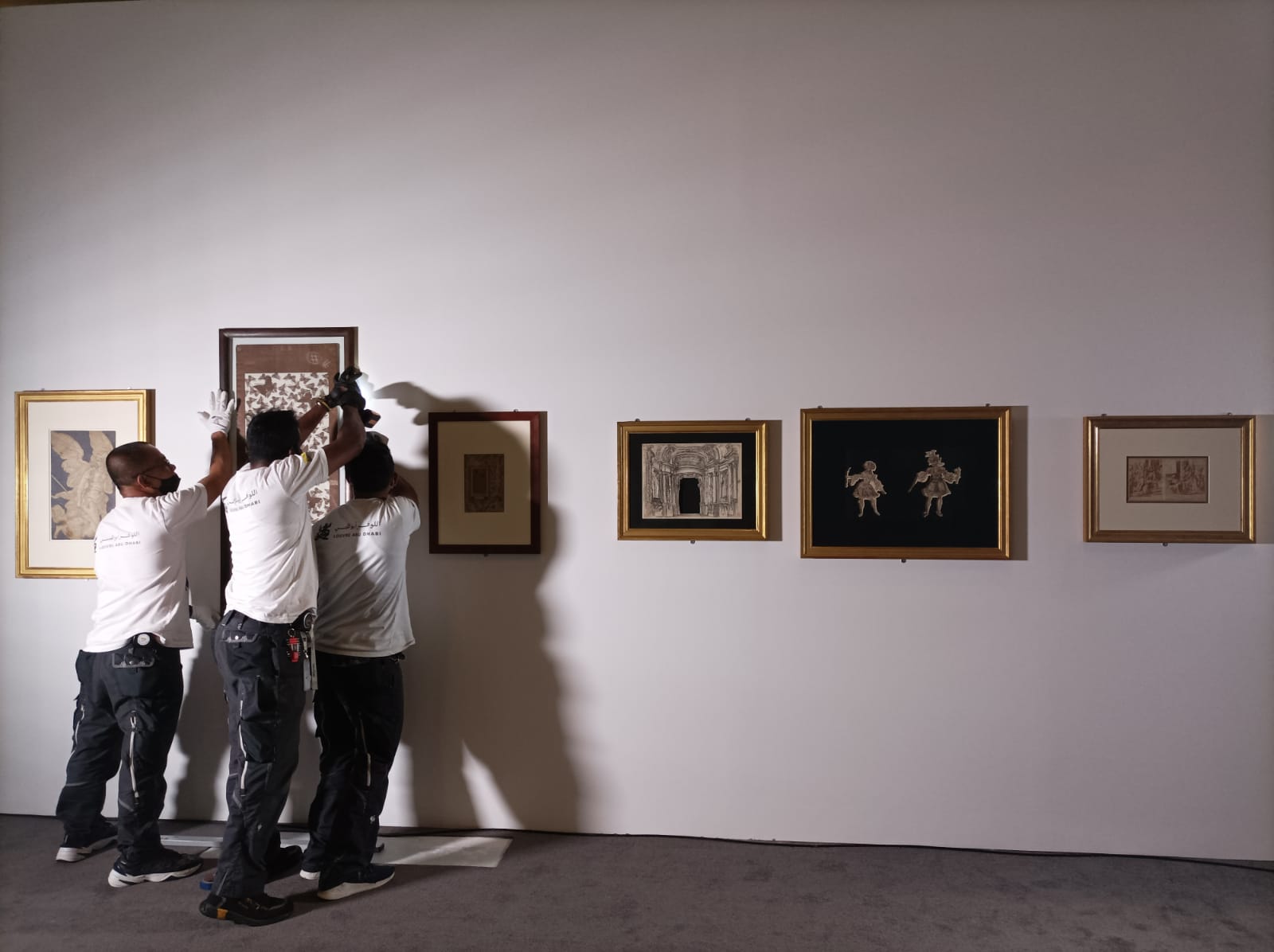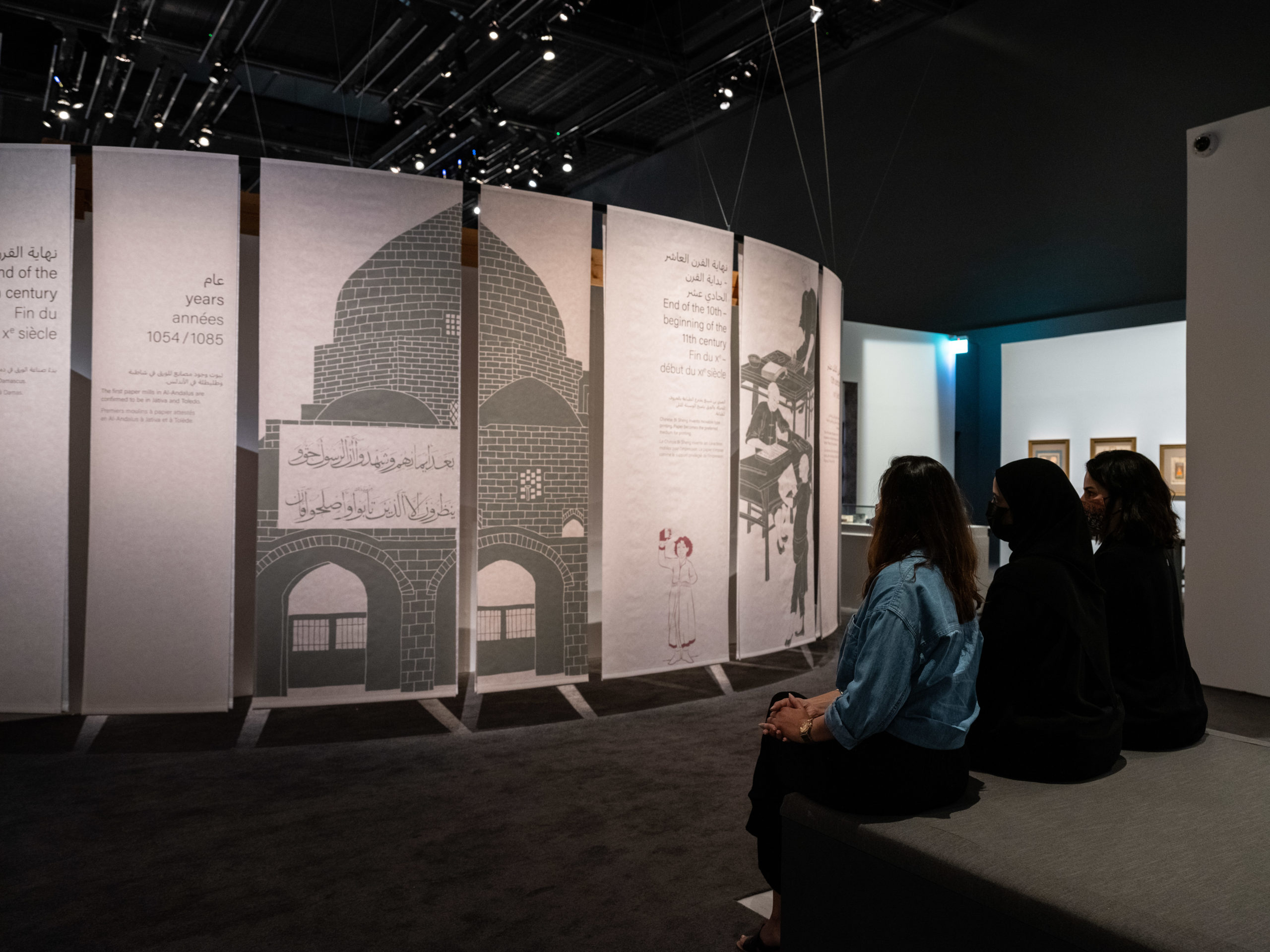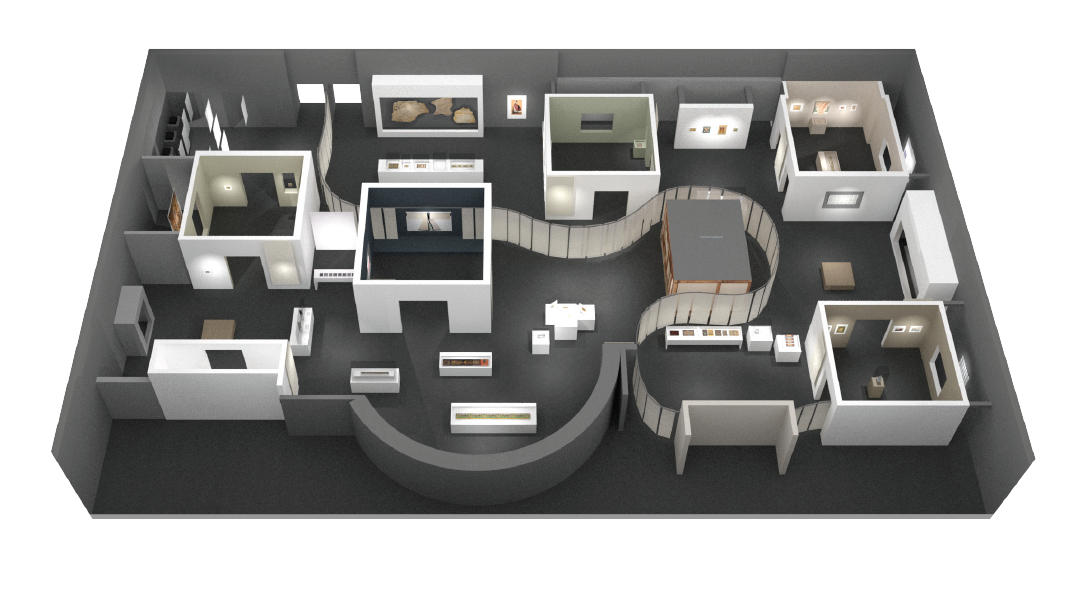Stories of Paper – Building a dialogue between exhibits and scenography
Jointly organised by France Muséums, Musée du Louvre and Louvre Abu Dhabi, the new temporary exhibition “Stories of Paper” will take place from 20 April to 24 July 2022. This exhibition features important loans, especially from the Graphic Arts and Islamic Arts departments of the Louvre, the Musée Guimet, the Bibliothèque Nationale de France, the Centre Pompidou, the Sharjah Art Foundation and the Zayed National Museum, as well as artworks from Louvre Abu Dhabi’s permanent collections. Also featured are contemporary artworks from the Arab and European art scenes.
Curated by Xavier Salmon and Victor Hundsbuckler, respectively Director and Conservator of the Musée du Louvre Graphic Arts department, the exhibition explores the countless opportunities paper offers for artistic expression and encourages visitors to take a fresh look at this everyday material that has become less widely used in the digital era. These “stories of paper” give visitors the chance to discover points of convergence between different civilisations in innovative, palpable ways.
STORYTELLING SUPPORTED BY SCENOGRAPHY
From manufacturing to distribution and technical progress, “Stories of Paper” illustrates the many characteristics of paper, a familiar material that has sometimes fallen out of use and been replaced by digital technology, which is now firmly established in every aspect of our lives. The exhibition has been an opportunity to design innovative display techniques and a unique scenography. Twelve themes exploring paper, from movement to colour and from fibre to form, highlight the properties of this multi-facetted material.
The exhibition scenography lies at the heart of the creative process and the France Muséums teams have used their extensive expertise to create a visitor journey that best suits the subject. This article focuses on this unique layout created by exhibition designer Laurence Fontaine in collaboration with the France Muséums project team: Claire Monneraye, Project Manager | Deputy to the Exhibitions and Publications Director; Sandra Mazière, Chief Registrar | Deputy to the Exhibitions and Publications Director; Lise Iguedjtal, Artwork Registrar; Pauline Vernières, Temporary Exhibition Officer; Sabrina Mathieu, Museography Project Manager; and Orlane Lefeuvre, Mediation and Programming Officer.
Everything begins with a story to be told. The exhibition layout and design, also known as the “scenography”, showcases and contextualises the artworks, organises the visitor journey, makes the whole experience meaningful and gives it a particular look and feel. It makes it possible to share a story, a concept and an emotion. As in a theatre, the idea is to “stage” a series of exhibits so that they converse with one another and form a coherent story. Scenography is the medium, the connection, the backdrop, the pathway and the guide of the visitor through the exhibition. It might be understated or awe-inspiring. By organising, articulating and displaying the exhibits, the exhibition shares a message that is enriched by the way it is presented. However, in some schools of thought the design is intended to be as neutral as possible, staying discreetly in the background so that the viewer’s eye focuses on the exhibits alone.
For “Stories of Paper”, the designers and curators, advised and supported by France Muséums, were eager to play with the design and layout so that they form part and parcel of the exhibition, almost comprising an artwork in and of themselves. Using paper for the exhibition design itself pushes the narrative as far as it will go, taking visitors on an immersive and all-embracing journey of discovery.
EXHIBITION DESIGN FROM COMMISSION TO PROJECT
The challenge for the exhibition designer is to create a highly engaging visitor journey. This journey must be subtle enough to provide freedom and clear enough to provide guidance. The visit must also have its own tempo, with pauses and accelerations like a piece of music. The scenography plays with framing and perspective, creating something akin to an architectural walk. It must be a fulfilling experience for the visitor. It is there to highlight an artist’s approach or a curator’s ideas and understanding. The scenography of “Stories of Paper” not only reinforces and supports the curator’s message, it physically embodies its subject, forming a living whole.
Exhibition design is an interaction between space (an exhibition venue) and content (the exhibits). Unlike with theatre set design, the visitor walks through an exhibition and constantly experiences new perspectives.
“I like designs that are fully present in the space and within the perspectives they create instead of being mere backdrops,” explains Laurence Fontaine, who designed “Stories of Paper”.
“What interests me is how space can be made to guide the visitor without taking precedence over the exhibits or the storytelling. When you’re designing an exhibition and crafting a visitor journey, it’s important to put yourself in the visitor’s shoes. You have to imagine how people are actually going to walk through the space you organise”.
This exhibition has been designed to highlight the physical reality of paper. To do this, the space has been divided up to recreate a “Louvre Abu Dhabi inside the Louvre Abu Dhabi” made up of six cubes punctuating the visitor journey: a series of solids and voids forming 12 separate sections in which the exhibits are displayed.
A curved paper wall runs through the entire exhibition; it bears a timeline featuring graphics that tell the story of paper and audio-visual tools. This strip of paper is an independent element that interconnects the 12 sections. It runs through the entire exhibition like time running through the different themes—which are themselves timeless.
The original idea was to use different types of paper for this display wall in order to highlight the diversity of paper as a material, but to comply with fire and safety regulations the design team opted for a special kind of paper called “drop paper”. The exhibition design had to be adapted to fit these constraints and solutions had to be found so that the “soul” of the project would remain intact. Paper has also been used for the exhibit captions and around the doorways.
The design and layout also have to cope with the technical parameters of the space. An exhibition space that has its own particular DNA often allows the designer and teams to base their design on something tangible and physical. The spaces at Louvre Abu Dhabi are more complex as they are completely empty. This means more creative freedom, but it also raises the challenge of filling the empty space in a way that doesn’t look too artificial.
“With empty galleries like the ones at Louvre Abu Dhabi, you’re free to invent the visitor journey but there are potentially more pitfalls to avoid,” explains Laurence Fontaine.
Creating an exhibition about paper also means raising the issue of natural resources and sustainable exhibition management. The France Muséums teams helped the design team, the curators and the teams at Louvre Abu Dhabi to find concrete solutions. External constraints often make it difficult to implement sustainable solutions when designing, installing and dismantling an exhibition, but France Muséums is always eager to place its expertise at the teams’ disposal so that sustainable initiatives can be developed.
Most of the furniture used for “Stories of Paper” (showcases, plinths, tables, benches, etc.), as well as the lighting, come from previous temporary exhibitions. The paper materials made specially for the exhibition will be recycled.
France Muséums continues to adopt the sustainable approach to the transportation of exhibits initiated during the pandemic. The France Muséums CSR policy, which defines criteria for shipping offers, has been applied to our shipping specifications since 2021. According to these specifications, shipping and haulage firms now have to provide carbon audits for emissions generated by their services. France Muséums also uses hybrid transportation methods, offers grouped shipping solutions for exhibits and optimises the type of shipping crates used. This requires a high degree of adaptability and efficient data sharing. For a museum like Louvre Abu Dhabi, these initiatives really matter as they foster best practices not only within the museum but also among exhibition partners and suppliers (lending institutions, fitters, shipping and haulage firms, exhibition designers, etc.).
France Muséums is committed to encouraging such best practices and builds sustainable initiatives into its projects, for example raising the awareness of suppliers and lenders on environmental issues and highlighting the importance of using more sustainable materials for the shipping, installation and conservation of exhibits. The France Muséums team also has two restorers—an experienced restorer working in tandem with a young graduate as part of a training process—to assess the condition of exhibits on loan for temporary exhibitions.
HOW EXHIBITION DESIGN SUPPORTS MEDIATION
Exhibition design is a form of spatial mediation. It acts as an interface between the creator, the object and the audience. It takes the form of different idioms to provide a story the public can understand.
“Stories of Paper” is designed to make the subject come alive. The exhibition design forms an integral part of the mediation process. The aim is to form an extension of the exhibits without overshadowing them, to guide the viewer’s eye, and to contextualise the exhibits by shifting our perspective and hinting at what lies outside the frame.
France Muséums and its mediation teams are involved at the earliest stages of the exhibition design process, identifying major themes and suggesting coherent interpretive solutions. For this exhibition, France Muséums provided mediation expertise in three main stages.
At first, on the signage thanks to the paper ribbon, which is both a display medium for the signage and a signage system in its own right, while bands of paper are also used for the main introductory texts.
The project team designed three mediation tools to support the visitor journey. Here again, the aim was to leverage the full potential of the exhibition design in order to ensure continuity and to use fun visual installations whose educational value lies mainly in the joy of discovery. The solutions used were designed to rest on the large paper strip that connects the different sections of the exhibition. The project teams were supported by On-situ, a firm that specialises in the production of cultural multimedia installations.
The first mediation solution, used at the beginning of the exhibition, is a film projected onto strips of paper with an immersive soundtrack. This introduces the subject of the exhibition by presenting different paper-making techniques in different parts of the world from the plant to the finished product.
The second interpretive tool invites visitors to take part in the exhibition and discover the different types of plants used to make paper. Having selected a piece of paper on an interactive table, visitors find out where it comes from and its vegetal origin through an animated presentation projected onto the display wall.
The third mediation solution is projected directly onto the paper ribbon. Clever lighting effects present the concept of watermarks and reveal the origins of paper projected onto several artworks.
Paper is also at the heart of the interpretive solutions designed for young visitors. Designed with the help of France Muséums, kid-friendly educational resources made of paper focus on the main themes of the exhibition. A mascot pops up at different points to explain the history of paper, the way it has been used over the centuries, and how important it is to preserve it.
Exhibits, exhibition design, mediation and signage together form a living structure that supports visitors and immerses them in a particular story. From design to installation, France Muséums works closely with expert professionals to create an innovative experience designed to enhance visitors’ understanding and enjoyment of what is on display.






